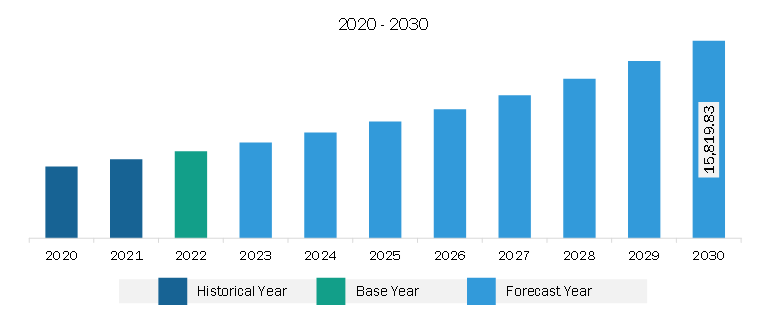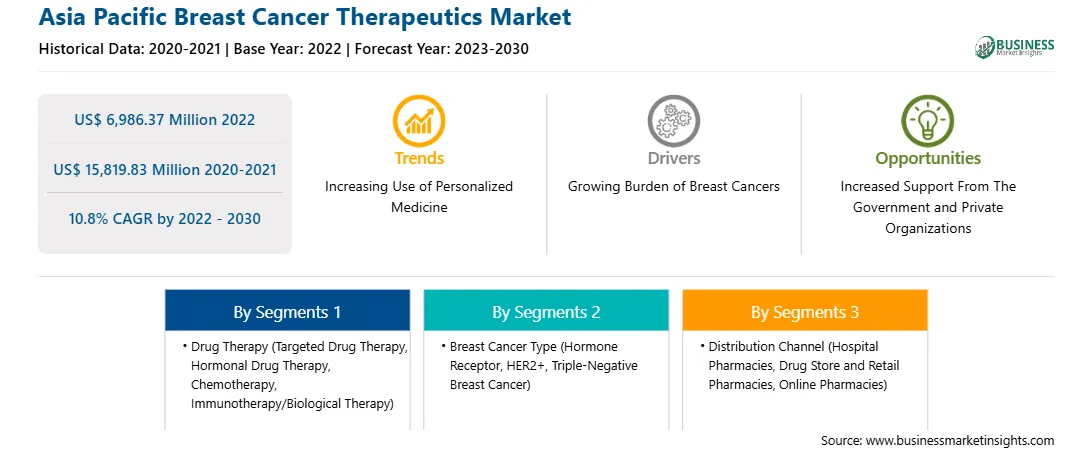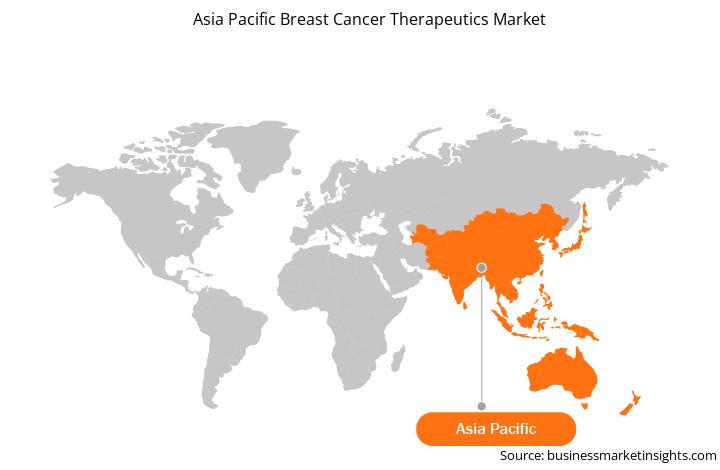The Asia Pacific breast cancer therapeutics market was valued at US$ 6,986.37 million in 2022 and is expected to reach US$ 15,819.83 million by 2030; it is estimated to grow at a CAGR of 10.8% from 2022 to 2030.
Launch of Several Diagnostics and Screening Programs Fuels the Asia Pacific Breast Cancer Therapeutics Market
Advancements in personalized medicine, immunotherapy, combination therapies, drug delivery systems, liquid biopsies, AI, and patient-centric approaches are expected to shape the future of breast cancer treatment. These trends aim to improve treatment outcomes, reduce side effects, and enhance breast cancer patients overall quality of life.
Early disease detection plays a major role in improving patient outcomes and survival rates. Various organizations and healthcare providers are implementing screening programs to detect breast cancer at an initial stage when it is more treatable. The World Health Organization released a new Global Breast Cancer Initiative Framework in February 2013 that serves as a plan for fulfilling the goal of saving 2.5 million people from breast cancer by 2040. To achieve this, the new Framework, unveiled ahead of the World Cancer Day campaign, urges nations to follow the three pillars of health promotion for early detection, prompt diagnosis, and thorough management of breast cancer. These programs often include mammography, clinical breast exams, and self-breast exams to identify any abnormalities or signs of breast cancer. Implementing these programs has increased awareness and early detection of breast cancer cases, resulting in higher demand for effective therapeutics.
In addition, many advancements in diagnostic technologies have been witnessed across the globe. The National Library of Medicine states that early detection and precise diagnosis are essential for enhancing prognosis. Breast cancer assessment frequently makes use of radiographic imaging modalities such as digital mammography (DM), digital breast tomosynthesis (DBT), magnetic resonance imaging (MRI), ultrasound (US), and nuclear medicine procedures. Histopathology (HP) is the gold standard for determining the presence of cancer. Furthermore, using artificial intelligence (AI) technology to depict medical images quantitatively has significant potential for improving breast cancer segmentation, diagnosis, and prognosis. These technologies help healthcare providers identify the extent and characteristics of the tumor, allowing them to develop personalized treatment plans. Thus, the launch of diagnostic and screening programs, coupled with advancements in diagnostic technologies, contributes to the Asia Pacific breast cancer therapeutics market growth.
Asia Pacific Breast Cancer Therapeutics Market Overview
The breast cancer therapeutics market in Asia Pacific is segmented into China, Japan, India, South Korea, Australia, and the Rest of Asia Pacific. The market growth is attributed to factors including growing burden of breast cancers among women coupled with advancements in personalized medicine, immunotherapy, combination therapies, and drug delivery systems.
The breast cancer therapeutics market in China is projected to witness substantial growth in the coming years, owing to the rising prevalence of breast cancer, increasing aging population, lifestyle changes, and others. China accounted for 24% of cases with new diagnoses and 30% of cancer-related fatalities globally in 2020, as per CDC statistics published on April 14, 2023. Over the last three decades, the age-standardized incidence of breast cancer climbed from 17.07 per 100,000 in 1990 to 35.61 per 100,000 in 2019. Advancements in treatment options have played a crucial role in driving the demand for breast cancer therapeutics in China.
Also, out of 1 in 10 women in Japan will acquire breast cancer at some point. The pink ribbon campaign in October and other initiatives have raised awareness of the disease among Japanese people, including the importance of self-checks and other early detection methods that, when used, increase the survival rate to over 90%. The identification of typical risk variables, however, lags. Thus, the breast cancer therapeutics market in Japan is expected to grow significantly due to an aging population, treatment options, government initiatives and policies, high healthcare expenditure, rising awareness, and technological advancements.
Asia Pacific Breast Cancer Therapeutics Market Revenue and Forecast to 2030 (US$ Million)

Strategic insights for the Asia Pacific Breast Cancer Therapeutics provides data-driven analysis of the industry landscape, including current trends, key players, and regional nuances. These insights offer actionable recommendations, enabling readers to differentiate themselves from competitors by identifying untapped segments or developing unique value propositions. Leveraging data analytics, these insights help industry players anticipate the market shifts, whether investors, manufacturers, or other stakeholders. A future-oriented perspective is essential, helping stakeholders anticipate market shifts and position themselves for long-term success in this dynamic region. Ultimately, effective strategic insights empower readers to make informed decisions that drive profitability and achieve their business objectives within the market.

| Report Attribute | Details |
|---|---|
| Market size in 2022 | US$ 6,986.37 Million |
| Market Size by 2030 | US$ 15,819.83 Million |
| Global CAGR (2022 - 2030) | 10.8% |
| Historical Data | 2020-2021 |
| Forecast period | 2023-2030 |
| Segments Covered |
By Drug Therapy
|
| Regions and Countries Covered | Asia-Pacific
|
| Market leaders and key company profiles |
The geographic scope of the Asia Pacific Breast Cancer Therapeutics refers to the specific areas in which a business operates and competes. Understanding local distinctions, such as diverse consumer preferences (e.g., demand for specific plug types or battery backup durations), varying economic conditions, and regulatory environments, is crucial for tailoring strategies to specific markets. Businesses can expand their reach by identifying underserved areas or adapting their offerings to meet local demands. A clear market focus allows for more effective resource allocation, targeted marketing campaigns, and better positioning against local competitors, ultimately driving growth in those targeted areas.

1. Eli Lilly and Co
2. Eisai Co Ltd
3. Novartis AG
4. AstraZeneca Plc
5. Pfizer Inc
6. Gilead Sciences Inc
7. Merck & Co Inc
8. Teva Pharmaceutical Industries Ltd
9. Amgen Inc
The Asia Pacific Breast Cancer Therapeutics Market is valued at US$ 6,986.37 Million in 2022, it is projected to reach US$ 15,819.83 Million by 2030.
As per our report Asia Pacific Breast Cancer Therapeutics Market, the market size is valued at US$ 6,986.37 Million in 2022, projecting it to reach US$ 15,819.83 Million by 2030. This translates to a CAGR of approximately 10.8% during the forecast period.
The Asia Pacific Breast Cancer Therapeutics Market report typically cover these key segments-
The historic period, base year, and forecast period can vary slightly depending on the specific market research report. However, for the Asia Pacific Breast Cancer Therapeutics Market report:
The Asia Pacific Breast Cancer Therapeutics Market is populated by several key players, each contributing to its growth and innovation. Some of the major players include:
The Asia Pacific Breast Cancer Therapeutics Market report is valuable for diverse stakeholders, including:
Essentially, anyone involved in or considering involvement in the Asia Pacific Breast Cancer Therapeutics Market value chain can benefit from the information contained in a comprehensive market report.